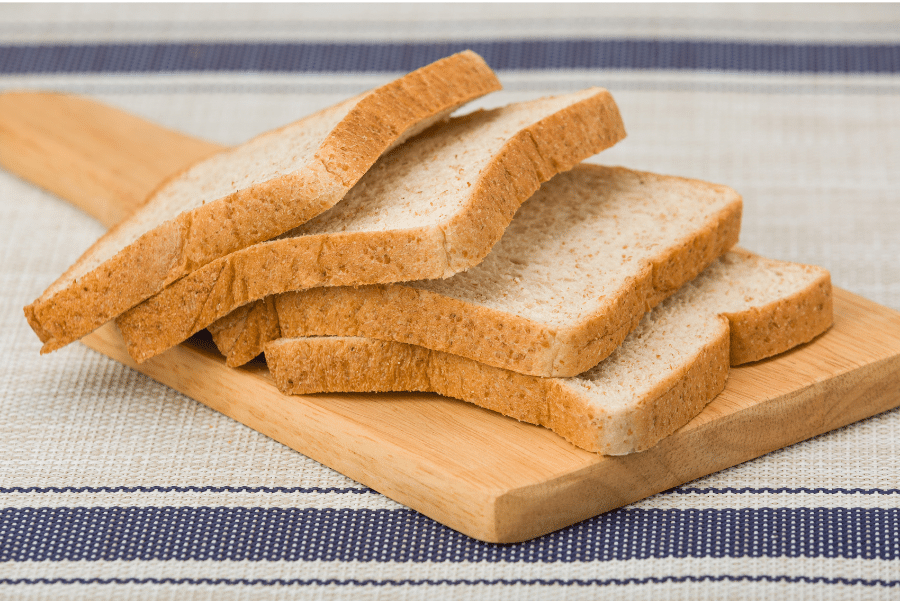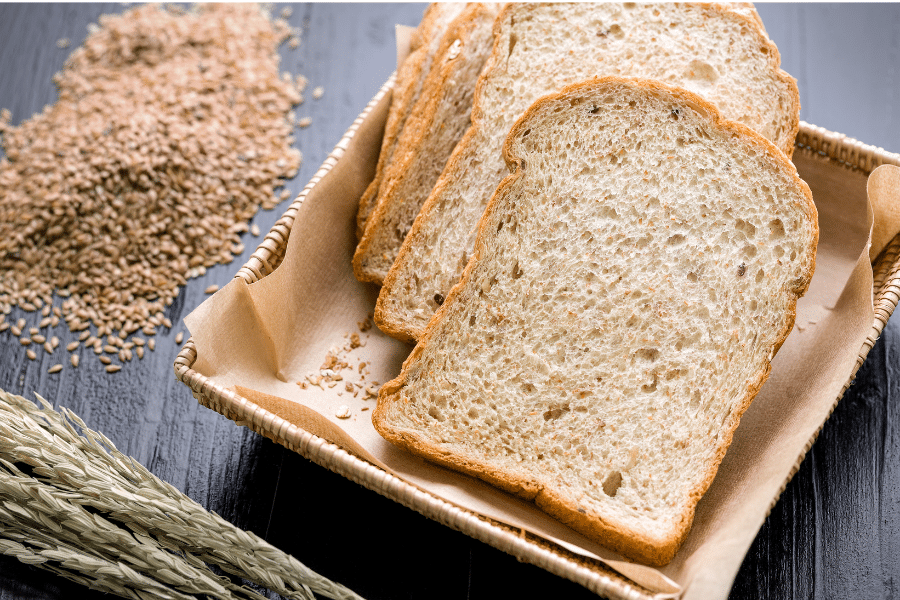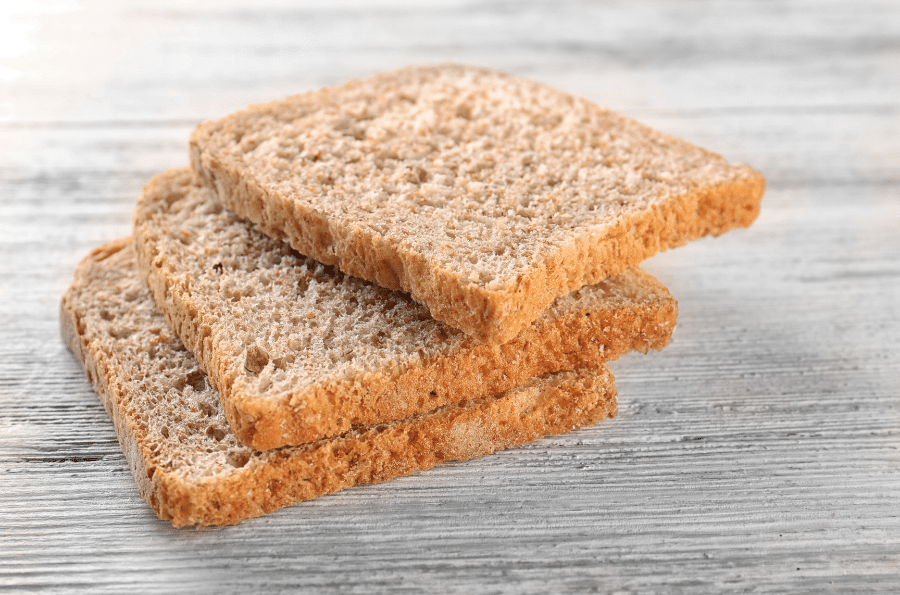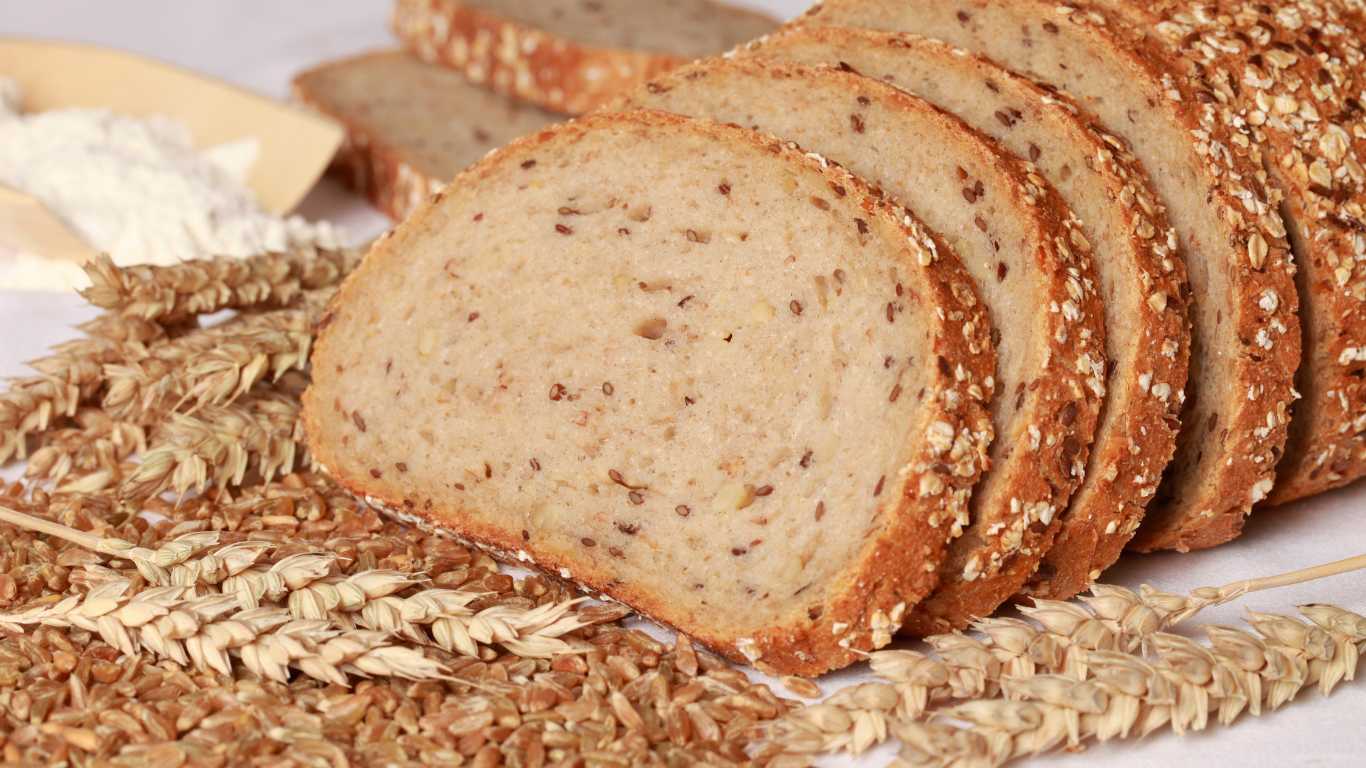Brown bread is often promoted as part of a balanced diet, but is it really healthy? We review the nutrition facts and share five reasons to include this nutritious food in your routine.
What is brown bread?
Brown bread is a general term used to describe whole wheat or whole grain bread varieties. These types of bread tend to have a darker color (light-medium brown) than bread made with enriched wheat flour, which is white.

Brown Bread nutrition facts
The nutrient content of brown bread, such as whole grain or whole wheat bread, will vary depending on the manufacturer. The information below represents an example of an average store-bought whole wheat bread. Always refer to the nutrition facts table on a product for the most accurate and up-to-date nutrition facts.
Serving size: 2 slices of bread
Calories: 170
Fat: 2g
Saturated: 0.4g
Sodium: 290mg
Potassium: 150mg
Carbohydrates: 31g
Fiber: 4g
Sugar: 3g
Protein: 7g
Other nutrients: Calcium: 75mg, Iron 1.75mg, Thiamine 0.15mg; Riboflavin 0.075mg; Niacin 2mg; B6 0.1mg; Pantothenate 0.5mg; Phosphorus 125mg; magnesium 45mg; Zinc 1.25mg; Manganese 1.05mg.
*Note: nutrition facts are from Depster’s 100% Whole Wheat bread.
Brown Bread vs. White Bread
The biggest difference between white and brown bread is how the breads are made. This may not be evident on a food label, but significantly changes how we digest and process the two different types of bread. White bread contains refined wheat flour. When refined flour is made, the outer parts of the whole-grain kernel are stripped away. These parts contain much of the fiber and micronutrient content found in the grain. What remains is the inner layer of the grain, which creates a silky, white flour. On the other hand, brown bread contains whole grain or whole wheat flour, which is made using the entire grain. This means that all of the nutrition found in whole grains is intact in brown bread (1).
Brown Bread vs. White Bread – Nutrition Facts
| Brown Bread | White Bread | |
|---|---|---|
| Calories | 170 | 170 |
| Fat (g) | 2 | 1.5 |
| Saturated (g) | 0.4 | 0.3 |
| Sodium (mg) | 290 | 290 |
| Potassium (mg) | 150 | 50 |
| Carbohydrates (g) | 31 | 34 |
| Fiber (g) | 4 | 1 |
| Sugar (g) | 3 | 4 |
| Protein (g) | 7 | 6 |
| Calcium (mg) | 75 | 75 |
| Iron (mg) | 1.75 | 2.25 |
| Thiamine (mg) | 0.15 | 0.3 |
| Riboflavin (mg) | 0.75 | 0.2 |
| Niacin (mg) | 2 | 3 |
| B6 (mg) | 0.1 | N/A |
| Pantothenate (mg) | 0.5 | N/A |
| Phosphorus (mg) | 125 | 50 |
| Magnesium (mg) | 45 | 15 |
| Zinc (mg) | 1.25 | 0.5 |
| Manganese (mg) | 1.05 | 0.3 |
Compared to white bread, brown bread contains similar calorie content. The fat content in brown bread may be slightly higher than white bread, as whole grains naturally have trace amounts of fats within the kernels. The sodium content of breads will vary depending on the brand. In this case, the same brand of white bread and brown bread have a similar sodium content. Potassium content is generally higher in brown bread, as whole grains are a natural source of potassium.
The total carbohydrate content of brown vs. white bread is often similar, but the types of carbohydrates differ. Brown bread is higher in fiber, with 4g per 2 slices vs. 1g of fiber in 2 slices of white bread. The protein content of brown bread is often higher than white bread, as some of the protein found in whole grains whole is stripped away in the production of white bread.
Brown Bread vs. White Bread – Micronutrient Content
Although most of the vitamins and minerals naturally found in whole grains are removed during the processing of refined flour, these vitamins and minerals are added back later in processing, which is why white flour is often referred to as “enriched.” For this reason, the micronutrient content in white and brown bread is often very similar, and in some cases, white bread contains higher amounts of vitamins and minerals, such as iron. On the other hand, brown bread is naturally a healthy choice as it is made with whole grain flour and contains naturally occurring vitamins and minerals, such as B vitamins, iron, zinc, and magnesium (1).
Be Aware of Hidden Sodium
While brown bread is healthy in many ways, bread in any form can be a hidden source of sodium. A typical slice of brown bread contains ~70-150mg of sodium. If using two slices of bread for a sandwich, a higher sodium bread can significantly increase the sodium content of your meal. We suggest choosing a bread with less than 230mg of sodium per serving (2 slices) for a moderate sodium bread.
If your healthcare provider has recommended that you follow a low-sodium diet, choosing bread with less than 115mg of sodium per serving (2 slices) is typically recommended. Note: always check with your healthcare provider about your specific sodium needs. If you’re looking for low-sodium bread options, check out our roundup of 15 Low Sodium Bread Brands at the Grocery Store for a complete list.

Health Benefits of Brown Bread
1. High Fiber Content
Brown bread is an excellent source of fiber, with 2-11g per slice, depending on the brand. A high-fiber diet from whole grains, legumes, fruits, and vegetables has been long associated with positive health outcomes.
Specifically, a high-fiber diet can help reduce cholesterol levels, lower A1C or fasting blood sugar levels in those with type 2 diabetes, improve digestion and increase post-meal satiety (fullness), and reduce the risk of heart disease, type 2 diabetes, and some cancers. Since bread is a staple food in North America, choosing a higher fiber option can help to boost your daily intake (2,3,4).
2. Lower Glycemic Load
Glycemic index is a measure of how quickly a carbohydrate food digests into sugar and impacts blood sugars. It is recommended for optimal blood sugar control that we consume low-medium glycemic index foods most often. Brown bread such as Mixed Grain Bread, Spelt Bread, Whole Wheat or Whole Grain bread are categorized as medium to low glycemic index. In comparison, white bread is considered high glycemic index, meaning it digests much faster than brown bread and can cause a more significant increase in post-meal blood sugar (5).
Beyond where brown bread ranks on the Glycemic Index, studies support that consumption of whole grains leads to a much lower blood sugar response after meals compared to white or refined grains (6).
3. Higher Protein content
Brown bread contains a higher protein content than white bread, as whole grains are a natural source of protein. Including protein at each meal and snack helps you meet your daily protein needs and promotes the feeling of satiety after eating. A typical serving of brown bread contains between 4 and 11 grams of protein, which can significantly boost the protein content of your meal. For example, making a simple breakfast sandwich with whole grain bread, almond butter, and hemp seeds would add up to ~20g of protein, depending on the brand of bread used.
If you’re looking for an extra protein boost from your bread, check out our roundup of High Protein Bread Options at the Grocery Store for an easy way to boost your protein intake.
4. Rich in Essential nutrients
Since brown bread is made with the entire grain, all of the nutrients naturally found in whole grains are intact in brown bread. Brown bread is rich in a variety of micronutrients, such as iron, B vitamins Thiamine, Riboflavin, Niacin, B5 and B6, zinc, manganese, and magnesium. Including whole grain or whole wheat bread in your diet can significantly contribute to your daily intake of vitamins and minerals, making brown bread a healthy choice.
5. High in Potassium
Potassium is an electrolyte found in whole grains, fruits, vegetables, and dairy products. Brown bread is an excellent source of potassium, with ~150mg per serving, depending on the brand. Potassium’s main role in the body is maintaining fluid balance within our cells. By doing so, potassium can help reduce blood pressure as it works against sodium. In addition, a diet rich in potassium is associated with potential benefits related to bone health, kidney disease, and reduced risk of kidney stones (8).

Bottomline: brown bread is a healthy option to add to your meal routine. It is a complex carbohydrate that is high in fiber, low-medium Glycemic Index, and is rich in protein and essential vitamins and minerals.
Do you use brown bread as part of your typical diet? Let us know in the comments below!
Sources:
- What About Wheat, Enrichment and Fortification. Accessed October 2023.
- Fibre, Health Canada (2019)
- Dahl WJ, Stewart ML. Position of the Academy of Nutrition and Dietetics: Health Implications of Dietary Fiber. J Acad Nutr Diet. 2015 Nov;115(11):1861-70. doi: 10.1016/j.jand.2015.09.003. PMID: 26514720.
- Reynolds AN, Akerman AP, Mann J. Dietary fibre and whole grains in diabetes management: Systematic review and meta-analyses. PLoS Med. 2020 Mar 6;17(3):e1003053. doi: 10.1371/journal.pmed.1003053. PMID: 32142510; PMCID: PMC7059907.
- Canadian Diabetes Association, Glycemic Index Food Guide. Accessed October 2023.
- Musa-Veloso K, Poon T, Harkness LS, O’Shea M, Chu Y. The effects of whole-grain compared with refined wheat, rice, and rye on the postprandial blood glucose response: a systematic review and meta-analysis of randomized controlled trials. Am J Clin Nutr. 2018 Oct 1;108(4):759-774. doi: 10.1093/ajcn/nqy112. PMID: 30321274.
- McLean RM, Wang NX. Potassium. Adv Food Nutr Res. 2021;96:89-121. doi: 10.1016/bs.afnr.2021.02.013. Epub 2021 May 24. PMID: 34112360.
- Weaver CM. Potassium and health. Adv Nutr. 2013 May 1;4(3):368S-77S. doi: 10.3945/an.112.003533. PMID: 23674806; PMCID: PMC3650509.


